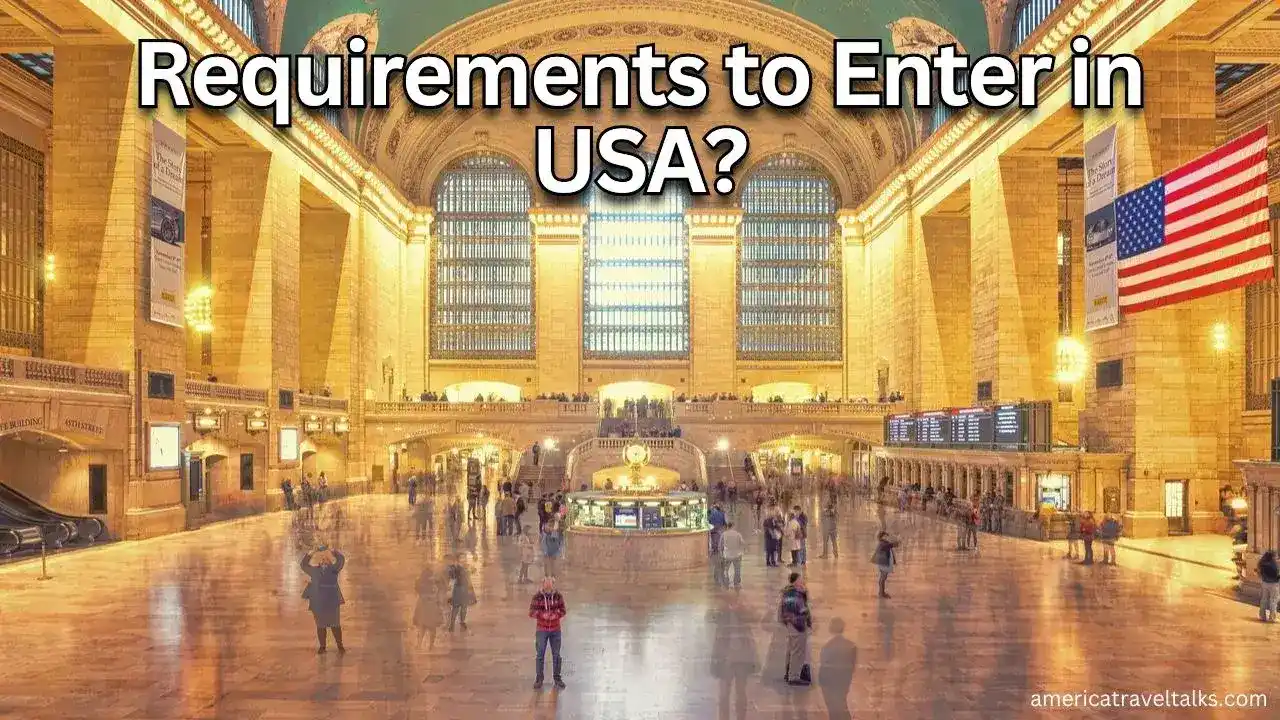
Entering the United States involves navigating through diverse requirements and regulations. From obtaining the appropriate visa to meeting essential criteria, understanding these prerequisites is crucial for a smooth and successful entry. The process varies based on the purpose of travel, with different visa types catering to tourism, business, education, or family reunification.
Tourists typically require a B-2 visa, while business travelers may apply for a B-1 visa. Students need an F-1 visa for academic pursuits. Family-sponsored visas and employment-based visas are available for those seeking permanent residency. Regardless of the visa type, a comprehensive application, including proof of financial stability and intent to return home, is essential.
Additionally, compliance with health and security regulations is vital. Recent changes in immigration policies and pandemic-related protocols may impact the entry process. Staying informed and seeking professional guidance can contribute to a seamless experience when entering the United States.
Visa Types
Entering the United States involves selecting the right visa, with various options designed for specific purposes. Tourist visas cater to temporary visits, work visas facilitate employment, student visas support academic pursuits, and family-sponsored visas enable reunification. It’s crucial to align your choice with the purpose of travel.
Choosing a tourist visa allows entry for a temporary stay, while work visas are ideal for those seeking employment opportunities. Student visas provide access to academic institutions, and family-sponsored visas are designed to facilitate reunification with relatives already in the country.
Selecting the appropriate visa type involves understanding the specific requirements and application processes associated with each category. It’s important to thoroughly research the criteria and documentation needed for a successful entry. Staying informed about any policy changes or updates in immigration regulations is also essential for a smooth experience when entering the United States.
Tourist Visa Requirements
Entering the United States for a leisure trip begins with obtaining a tourist visa. Adequate preparation is key to a successful application, requiring thorough documentation, an understanding of the application process, and awareness of associated fees.
To initiate the process of entering the United States for leisure, individuals need to focus on obtaining a tourist visa. Adequate preparation is essential for a successful application. This involves gathering the necessary documentation, understanding the intricacies of the application process, and being aware of the fees associated with obtaining a tourist visa.
Documentation requirements typically include a valid passport, a completed visa application form, and proof of financial ability to support the trip. The application process involves scheduling a visa interview at the U.S. embassy or consulate in the applicant’s home country.
It’s crucial to be well-informed about the fees associated with the tourist visa application, ensuring that all financial aspects are addressed during the planning phase. By taking these steps, individuals can enhance their chances of a smooth and successful experience when entering the United States for leisure.
Work Visa Requirements
Entering the United States for employment requires professionals to meet specific criteria for obtaining a work visa. This section sheds light on the diverse categories of work visas, the requisite paperwork, and the approval process.
Professionals aspiring to work in the United States must navigate through specific criteria to secure a work visa. Understanding the various categories available is crucial. These include the H-1B visa for skilled workers, the L-1 visa for intracompany transferees, and the O-1 visa for individuals with extraordinary abilities.
The required paperwork for a work visa application typically involves submitting a job offer letter, educational qualifications, and evidence of specialized skills. The approval process includes a thorough review by U.S. immigration authorities, emphasizing the importance of meeting all eligibility criteria.
A successful entry into the United States for employment hinges on a comprehensive understanding of the specific requirements for the chosen work visa category. Professionals are advised to engage in meticulous preparation, ensuring a smooth application process and increasing the likelihood of approval.
Student Visa Requirements
Entering the United States for academic pursuits involves aspiring students meeting academic prerequisites and adhering to specific application procedures. This section delves into the eligibility criteria and steps essential for obtaining a student visa.
Aspiring students eager to enter the United States for academic pursuits must navigate through specific eligibility criteria. These criteria often include an acceptance offer from a U.S. educational institution, proof of financial ability to cover tuition and living expenses, and a completed visa application.
The application process for a student visa involves submitting the necessary documents to the U.S. embassy or consulate in their home country. Required documentation typically includes a Form I-20, proof of payment for the SEVIS fee, and a valid passport.
Successful entry into the United States for academic endeavors hinges on meticulous preparation and adherence to the application procedures. Aspiring students are encouraged to familiarize themselves with the eligibility criteria, gather all required documents, and ensure a seamless application process to increase their chances of obtaining a student visa.
Family-sponsored Immigration
Entering the United States through family-sponsored visas involves facilitating the reunification of family members. This section provides insights into the relationship criteria and the sponsorship process for those seeking family-based immigration.
For individuals aiming to enter the United States through family-sponsored visas, meeting specific relationship criteria is paramount. These criteria typically include being a spouse, child, parent, or sibling of a U.S. citizen or a lawful permanent resident. Understanding these relationships is crucial to initiating the sponsorship process.
The sponsorship process involves a U.S. citizen or permanent resident filing a petition on behalf of their family member. This petition, such as the Form I-130, serves as the initial step in the family-based immigration journey. Once approved, the sponsored family member can proceed with the visa application process.
Successfully entering the United States through family-sponsored visas relies on a clear understanding of the relationship criteria and meticulous completion of the sponsorship process. Individuals seeking family-based immigration are encouraged to navigate this process diligently to ensure a smooth reunification with their loved ones in the U.S.
Employment-based Immigration
Entering the United States for employment involves a nuanced understanding of employment-based visas. This section elucidates the qualifications and procedures for each category, guiding individuals through the intricacies of pursuing job opportunities in the U.S.
Professionals aspiring to work in the United States must grasp the diverse categories of employment-based visas. These encompass the H-1B visa for skilled workers, the L-1 visa for intracompany transferees, and the O-1 visa for individuals with extraordinary abilities. Each category has distinct qualifications and requirements.
Qualifications for employment-based visas typically include specialized skills, educational background, or exceptional abilities in a particular field. The application process involves submitting relevant documentation, including job offer letters, educational credentials, and proof of qualifications.
Navigating the procedures for each employment-based visa category is crucial for a successful entry into the United States for employment. Prospective applicants are advised to thoroughly understand the qualifications, gather the necessary documents, and adhere to the specific procedures outlined for their chosen visa category.
Green Card Requirements
Entering the United States permanently is facilitated through the acquisition of a green card, serving as a pathway to permanent residency. This section delves into the eligibility criteria, application process, and associated waiting periods.
For those aspiring to make the U.S. their permanent home, understanding the eligibility criteria for obtaining a green card is crucial. Common pathways include family sponsorship, employment-based preferences, refugee/asylee status, or through the Diversity Visa Program.
The application process involves meticulous submission of required documents, such as Form I-485, supporting evidence, and payment of associated fees. Depending on the pathway, applicants may need to undergo interviews and medical examinations as part of the comprehensive immigration process.
Waiting periods vary based on factors like the type of green card sought and the current demand. Family-sponsored green cards may have different waiting times than employment-based ones. Staying informed about processing times is essential for those considering the journey to permanent residency in the United States.
Customs and Border Protection (CBP)
Upon entering the United States, the role of Customs and Border Protection (CBP) takes center stage. This section unveils CBP’s responsibilities, screening procedures, and common issues encountered by travelers during their arrival in the U.S.
Customs and Border Protection (CBP) plays a pivotal role in ensuring the safety and security of the United States. Upon entering the country, travelers undergo thorough screening procedures conducted by CBP officers. These procedures include document verification, baggage inspections, and, at times, additional questioning.
CBP is responsible for enforcing various laws and regulations, including immigration and customs laws. Travelers are expected to comply with these regulations to facilitate a smooth entry process. Failure to adhere to entry requirements may result in delays, questioning, or even denial of entry.
Common issues faced by travelers often revolve around incomplete or inaccurate documentation, visa-related concerns, or misunderstandings regarding the purpose of the visit. Staying informed about CBP procedures and ensuring accurate paperwork is crucial for a seamless entry into the United States.
Security Clearance and Background Checks
Entering the United States involves a critical aspect: security clearance. This section delves into the significance of security clearance, the procedures governing it, and the timeframes associated with background checks.
Security clearance is an indispensable part of the entry process, ensuring the safety and integrity of the United States. The procedures for obtaining clearance involve thorough background checks on individuals seeking entry. These checks encompass criminal history, potential security risks, and affiliations that may impact national security.
The importance of security clearance lies in safeguarding against potential threats and maintaining national security. The timeframes for background checks can vary, influenced by factors such as the complexity of an individual’s history, the specific visa or entry category, and any potential flags that may arise during the screening process.
Understanding the intricacies of security clearance is essential for those entering the United States. Being transparent, providing accurate information, and cooperating with the screening process contribute to a smoother clearance experience, ensuring a secure and efficient entry into the country.
Health and Medical Requirements
Entering the United States involves mandatory health screenings aimed at safeguarding the well-being of the population. This section delineates the requisite health checks, vaccination requirements, and criteria for medical examinations during the entry process.
The U.S. mandates health screenings to ensure incoming travelers pose no health risks to the population. These screenings encompass thorough examinations, checking for contagious diseases, and adherence to vaccination requirements. Vaccination documentation may be mandatory, depending on the individual’s country of origin and current health guidelines.
Health screenings are integral to preventing the spread of communicable diseases. Travelers may be subject to medical examinations, especially if arriving from regions with prevalent health concerns. Understanding and complying with these health protocols are crucial for a smooth entry into the United States.
Adherence to vaccination requirements and cooperation during health screenings contribute to public health and safety. Travelers should stay informed about the latest health guidelines, ensuring they meet the necessary criteria to facilitate a secure and healthy entry into the United States.
Financial Requirements
Entering the United States involves a crucial step: demonstrating financial stability during the visa application process. This section delves into the requirements for proving financial capacity, encompassing proof of funds and financial sponsorship.
Demonstrating financial stability is a pivotal aspect of the visa application process, ensuring applicants can support themselves during their stay. Proof of funds, such as bank statements or sponsorship letters, is essential in showcasing the financial capacity to cover expenses, including accommodation, transportation, and living costs.
Requirements for proving financial capacity may vary based on the type of visa and the intended duration of stay. Applicants need to provide accurate and up-to-date documentation reflecting their financial situation. This may include income statements, employment verification, or details about a sponsoring entity’s financial commitment.
Financial sponsorship is a common means of meeting the financial requirements for entry into the United States. Sponsors must demonstrate their ability to support the applicant financially. Adequate documentation, transparency, and adherence to specific guidelines enhance the chances of a successful application and entry into the United States.
Visa Interview Process
Entering the United States involves a crucial juncture: the visa interview, a significant step in the application process. This section offers an overview of the interview and imparts valuable tips for a successful outcome.
The visa interview is a pivotal element of the entry process, allowing consular officers to assess an applicant’s eligibility and intentions. It typically involves questions about the purpose of the visit, ties to the home country, and the ability to finance the stay.
Tips for a successful visa interview include thorough preparation, familiarity with the specific visa category, and providing honest and concise answers. Dressing professionally, maintaining eye contact, and expressing confidence can positively impact the interview experience.
Applicants should anticipate questions related to their travel plans, background, and ties to the home country. Providing supporting documents when necessary and showcasing a genuine intent to abide by U.S. visa regulations enhances the likelihood of a favorable outcome during the interview process.
Common Pitfalls
Entering the United States demands a meticulous approach to the application process, emphasizing the importance of avoiding common mistakes. This section sheds light on pitfalls to steer clear of, offering valuable tips to enhance the chances of a successful entry.
Common mistakes during the application process can lead to delays or denials. Failing to provide accurate and complete information, submitting outdated documents, or overlooking specific requirements are pitfalls to be mindful of. Thoroughly reviewing the application and adhering to guidelines mitigates these risks.
Misrepresentation or providing false information can have severe consequences. Applicants should be transparent, ensuring that all details align with the truth. Any discrepancies can lead to visa denials or even bans on future entries into the United States.
Timeliness is crucial in the application process. Late submissions, whether in completing paperwork or attending appointments, can result in setbacks. Planning ahead, adhering to deadlines, and staying organized contribute to a smoother and more successful entry into the U.S.
Seeking professional guidance and staying well-informed about the latest immigration policies are key strategies. Consulting experts can help navigate complexities, avoid pitfalls, and enhance the overall success of the entry process into the United States.
Conclusion
In conclusion, entering the United States demands a meticulous process of meeting various entry requirements. Adhering to outlined criteria for different visa types is crucial, ensuring alignment with the purpose of travel and fulfilling necessary documentation for a successful entry.
Understanding the role of Customs and Border Protection (CBP) is essential upon entering the United States. CBP’s responsibilities, screening procedures, and potential issues faced by travelers underscore the importance of cooperation and compliance with immigration regulations.
Preparing for security clearance and background checks is a vital component of the entry process. Demonstrating transparency, providing accurate information, and cooperating during these screenings contribute to a secure and smooth entry into the United States.
Navigating through these steps, applicants can enhance their chances of a successful entry into the United States. Staying well-informed, seeking professional guidance when needed, and avoiding common pitfalls contribute to a seamless and positive experience when entering the country.
You may also like:
FAQs
Q1: Can I simultaneously apply for multiple visas?
A: Yes, simultaneous applications for multiple visas are allowed, provided the applicant meets the eligibility criteria for each visa type.
Q2: What happens if my visa application is denied?
A: In case of a denial, applicants will receive a letter stating the reason for rejection. Depending on the situation, there may be an option to appeal the decision.
Q3: How long is the usual visa application process?
A: Processing times vary based on the visa type. It is recommended to refer to official processing times for accurate information regarding the specific visa category.
Q4: Are there age restrictions for obtaining a visa?
A: Certain visa categories may have age restrictions. Applicants should review the specific requirements associated with the intended visa type.
Q5: Can I extend my stay in the U.S. after my initial entry?
A: Extensions are possible for certain visa types. Understanding the terms and conditions of the visa is crucial to exploring and applying for potential extensions.




